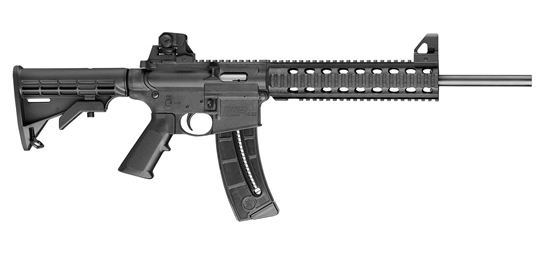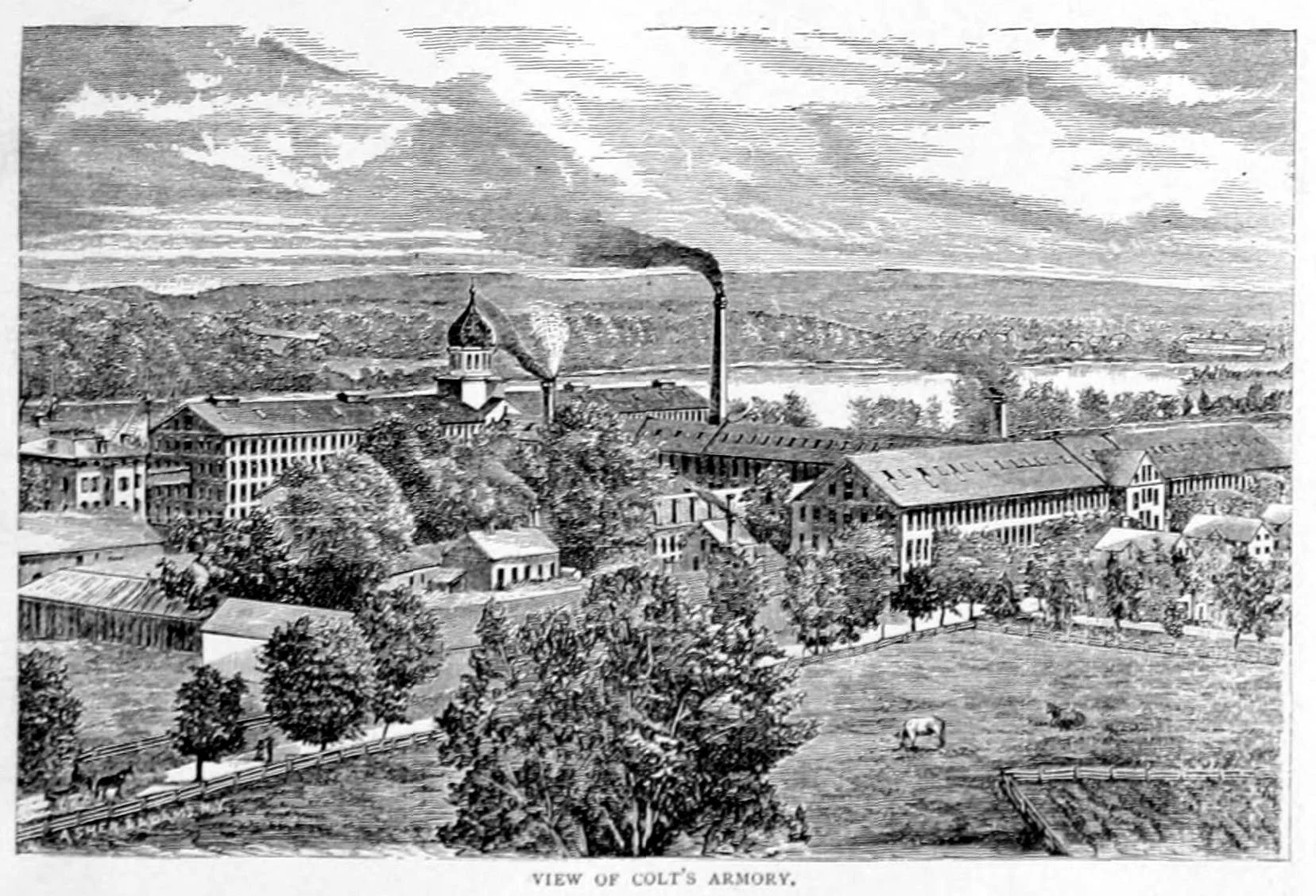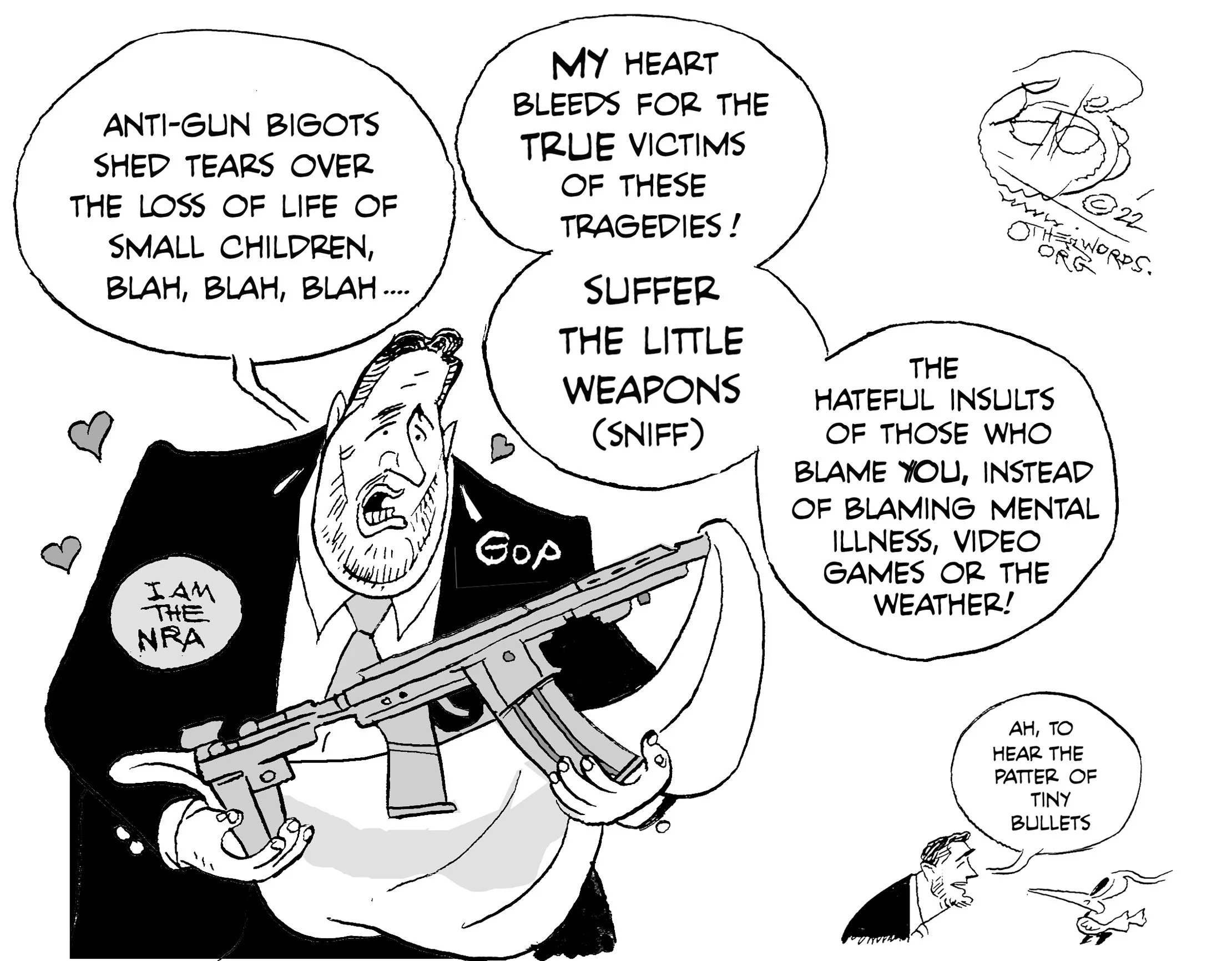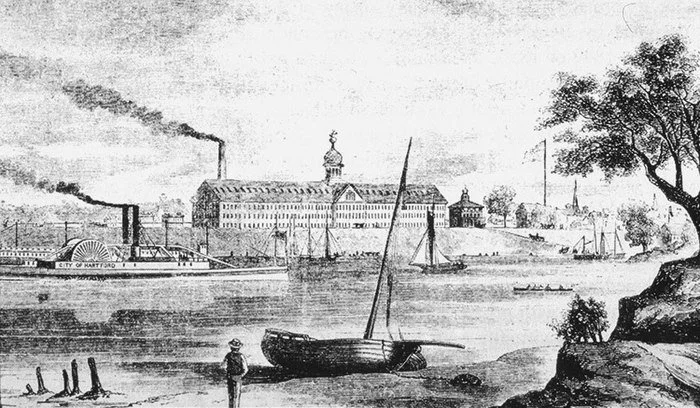
Nyla Samee, Khury Petersen: Past time to go after the gun makers
Springfield, Mass.-based Smith & Wesson’s M&P15-22 semiautomatic rifle
Via OtherWords.org
There is a familiar pattern after the mass shootings that have become a well-known feature of American life.
The initial shock and grief gives way to demands for greater regulation of gun ownership by Democrats, while Republicans dismiss such measures and blame mental illness instead. But if we actually want to do something about it, we need to have new conversations.
We often talk about where and how weapons are purchased — but rarely where and how they are manufactured. These realities challenge the conventional way we talk about guns in terms of a “culture war” between red and blue states.
1896 lithograph of Colt’s Manufacturing Co.’s factory and headquarters, in Hartford. The company is now based in West Hartford.
For example, the Blue states of Massachusetts and Connecticut have some of the strictest regulations on firearms carrying and possession. But they are also major sites of gun manufacturing in this country. The weapons used in the 2018 Parkland shooting, for example, were manufactured by Smith and Wesson, a gun manufacturer based in Springfield, Mass.
The deeper and bigger point is that the U.S. is the world’s principal supplier of weapons.
The U.S. weapons industry makes both heavy weapons, such as military aircraft, bombs, and missiles, and small arms like rifles and handguns. As of 2021, over 40 percent of the world’s exported arms came from the United States — many of them manufactured in deep blue states.
Blue states with strict gun laws often suffer gun violence when weapons are trafficked in from Red states with looser gun laws. Similarly, many countries surrounding the U.S. with high rates of gun violence, such as Mexico, obtain guns both legally and illegally from this country.
With no system to effectively control and track who ends up with those guns, these weapons are often obtained by military units or police that have committed human rights abuses or who work with criminal groups.
For example, in September 2014, local police in the state of Guerrero, Mexico, were responsible for the disappearance and murder some 43 students from the Ayotzinapa Rural Teachers College. The police were armed with rifles that were supplied legally from Colt, a prominent U.S. gun manufacturer based in Connecticut.
Most Americans, including most gun owners, support some level of gun control or background checks. But gun lobbies such as the NRA, which are so influential in Red states, don’t really represent gun owners — they represent gun manufacturers. In fact, of the NRA’s corporate partners, several are gun manufacturers based in Blue states.
As long as these corporations flood the U.S. and the world with guns, debate over who accesses these guns won’t get us very far.
So our current conversation serves the status quo. It further divides people in this country according to a “culture war” narrative, where politicians clash in rhetoric, but everyone knows that the actual situation will not change.
From the perspective of ending bloodshed, this isn’t working. We need to try something different, and it will mean some deeper interrogation about where these weapons come from.
This could mean reviewing the practices and impacts of gun manufacturers, demanding greater regulation, and — as with any product that causes far reaching harm — having a public conversation about whether companies should be allowed to make these weapons at all.
The mass production of guns has been a disaster — one that has dire consequences not only for U.S. communities, but for those all over the world. New ways of thinking will help us fulfill our responsibility to protect vulnerable people not just in the U.S., but people everywhere.]
Nyla Samee is a Next Leader at the Institute for Policy Studies, where Khury Petersen is an fellow.
‘The true victims’
An AR-15-style rifle
— Photo by Picanox
An AR-15-style rifle is any lightweight semi-automatic rifle based on the AR-15 design of Hartford, Conn.-based Colt’s Manufacturing Co., founded in 1855. It’s a favorite weapon of mass murderers.
Colt's Armory from an 1857 engraving, as viewed from the east side of the Connecticut River.
Don Pesci: Fact-checking Sen. Murphy's claims on gun control
An AR-15.
FactCheck.org recently examined a proposition put forward by Connecticut U.S. Sen. Chris Murphy who, according to some of his gun-toting critics, will not rest content until he has repealed the Second Amendment to the U.S. Constitution, abolished the National Rifle Association (NRA), and confiscated every "assault weapon" – assault guns, assault knives and, especially prominent just now in Europe, assault vans – from sea to shining sea.
“What we know, Murphy said, "is that states that have tougher gun laws, that keep criminals from getting guns, that keep those dangerous weapons like AR-15s out of the hands of civilians, have dramatically lower rates of gun violence."
FactCheck found that while Murphy was entitled to make up his own mind on assault weapons, he was not entitled to make up his own facts, and the senator was given three Pinocchios.
Let’s deal first with Murphy’s AR-15 claim, Fact Check began. In support of Murphy’s claim that tough gun laws in such places as Connecticut and Chicago that “keep criminals from getting guns, that keep those dangerous weapons like AR-15s out of the hands of civilians, have dramatically lower rates of gun violence," a Murphy spokesperson pointed to “several studies” that backed Murphy’s assertion.
Fact Check examined the studies, the bedrock upon which Murphy’s claims rest, and found: “None of the studies [cited by the spokesperson] address bans on assault weapons such as the AR-15, but the effectiveness of an assault weapons ban was widely studied after Congress imposed a nationwide 10-year ban in 1994.”
Pointing to one such study undertaken by Christopher Koper, of George Mason University, and his colleagues, FactCheck summarizes the finding of that study: “The effectiveness of the ban was inconclusive. Gun violence declined nationwide into the 2000s, but the researchers ‘cannot clearly credit the ban with any of the nation's recent drop in gun violence.' The researchers estimated that the effects of the ban 'may not be fully felt for several years into the future,’ and ‘'should it be renewed, the ban's effects on gun violence are likely to be small at best and perhaps too small for reliable measurement.’ The ban was not renewed.” Murphy’s claim is not supported by the study.
FactCheck notes the deficiencies of the ban itself: The 1994 ban “may not have covered all forms of assault weapons because it did not ban all semiautomatic weapons. Instead, it banned semiautomatic weapons with large-capacity magazines and weapons that ‘appear useful in military and criminal applications but unnecessary in shooting sports or self-defense.’"
The observation raises the ticklish question: What weapons would an effective ban exclude? And the honest answer to the question is all "assault weapons" -- possibly including the recently favored weapons of terrorists, such as knives, vans and exploding pressure cookers -- not to mention a repeal of the Second Amendment supported by former Hartford Courant columnist Bob Engelhart, and the confiscation of all guns in the United States, the Australia solution to gun violence.
The problem with partial bans is that they are “not comprehensive,” a favorite expression of the anti-Second Amendment left. Englehart is right: We should learn to speak of partial weapons bans with the same smiling contempt used by people who speak of partial pregnancies, partial round circles and partial square holes. The ban enacted into law in Connecticut, if nationally replicated, would not substantially drive down murder rates in Chicago or Hartford.
A recent 2016 study published in Criminal Justice Review, FactCheck notes, addressed “the connection between 19 different gun-control laws and violent crime in roughly 1,000 U.S. cities. Kleck [co-author of the study] found that ‘gun control laws generally show no evidence of effects on crime rates, possibly because gun levels do not have a net positive effect on violence rates.’ But there were a few exceptions. Requiring a license to possess a gun and bans on gun purchases by alcoholics appeared to reduce the homicide and robbery rate.” And, of course, the licensing of guns is as common as table salt. The gun violence figures recently used by Murphy as emotional props to acquire campaign funds include suicides, which account for nearly 60 percent of gun crimes.
On this latter point, Murphy defended himself from the Pinocchio assault by pointing out that suicide was also a violent crime. True enough, but it is a different kind of violent crime, entailing much different consequences, and the General Assembly in Connecticut doubtless would not have successfully passed laws banning the AR-15, a weapon not useful in suicides, had it been forced to argue that the ban would reduce the incidence of suicide alone. The shooter in Sandy Hook first murdered 27 innocent people, 20 of them children, and then turned a pistol on himself, committing suicide.
In a cooler movement, Murphy should ask himself whether the tears poured out in Connecticut and Las Vegas would have flowed so copiously if both shooters had committed suicide before they pulled the trigger on their many victims.
Don Pesci is a Vernon, Conn.-based columnist and a frequent contributor to New England Diary.
Robert Whitcomb: A little context, please, on race relations; for ferries; democracy in Vt.
This originated in GoLocalProv.com
The news media, for marketing reasons, and the general public, for psychological/emotional ones, generally want simple narratives of big events, preferably with clear villains and heroes, idiots and geniuses, not to mention vivid starts and banging ends. A recent narrative is that Britain’s exit from the European Union was suicidal and will be a world-historical catastrophe. No it won’t, as calmer members of the financial sector quickly realized.
Last week it was the shootings by police and then the lunatic Micah Xavier Johnson’s murder of five police officers. Tragic indeed, but the implication by some news media that America is somehow doomed to ever-widening conflict about race and related law-enforcement matters is ridiculous.
America -- like all nations! – has plenty of racism. But the progress that our huge, and complicated country has made in recent decades toward an inclusive and mostly un bigoted society is impressive. I can remember back when drinking fountains were segregated in the South. The United States is a far more just (except perhaps economically) and peaceful place now than it was in, say, 1968 -- the disorderly year to which 2016 is now compared by people who didn’t live through ‘68.
That three of the key personalities in commenting on last week’s racially related incidents -- Dallas Police Chief David Brown, President Obama and U.S. Atty. Gen. Loretta Lynch--- are African-American says something important.
Most Americans are ignorant of many basic facts of their nation’s history. About foreign matters they’re even worse: The bigotries in most of the world far exceed America’s. That’s one big reason that, for all our faults, so many people from the rest of the world want to move to the United States. Those denouncing extremely ethnically diverse America as somehow uniquely vicious in race relations ought to do more reading and traveling.
A couple of other observations spawned by last week’s horrors:
Some people complain about the “militarization of America’s police.’’ But what do they expect given that it’s so easy for nonpolice to buy or otherwise get military-style weapons? The NRA, its employees on Capitol Hill and the likes of Walmart that sell so many weapons have been the biggest militarizers of America. They’ve made the nation an armed camp, and the police have to protect themselves.
Meanwhile, an interesting story in the July 11 New York Times reports:
“A new study confirms that black men and women are treated differently in the hands of law enforcement. They are more likely to be touched, handcuffed, pushed to the ground or pepper-sprayed by a police officer, even after accounting for how, where and when they encounter the police.
“But when it comes to the most lethal form of force — police shootings — the study finds no racial bias.
“’It is the most surprising result of my career,” said Roland G. Fryer Jr., the author of the study and a professor of economics at Harvard and anAfrican-American.’’ Here’s the link:
The conventional wisdom can usually use a bit of editing.
xxx
Let’s hope that the return of warm-weather Providence-Newport ferry service, which will last just 10 weeks, helps get Rhode Island officials, working with the U.S. Transportation Department, to start year-round commuter services by boat around Narragansett Bay. TheBay’s coast is heavily populated, there are lots of harbors and the (bad) roads are often congested – all making Rhode Island a damn good place for ferries.
In Europe, most bodies of water with dense populations around them have ferry service, as does Massachusetts Bay. See: http://www.bostonharborcruises.com/commuters/
Boston Harbor Cruises (BHC) runs MBTA commuter boats that carry thousands of passengers to and from work each day, including the Inner Harbor Ferry between Charlestown Navy Yard and Long Wharf; the Hingham-to-Boston Ferry service, and the Hingham/Hull/Boston/Logan service. BHC also operates the Salem Ferry under contract with the City of Salem in the summer. Its slogan is: “Leave Gridlock in Your Wake’’.
What a fine economic-development tool ferries could be for a crowded state much of which is a bay.
xxx
Ah, Vermont, where citizens flock to hear local and state candidates take (usually) polite questions. Vermont and New Hampshire, for all their differences, have especially civic-minded and engaged citizens.
I saw an example last Sunday at a forum sponsored by the Washington and Orange County (Vt.) Republican committees, at which two smart candidates vying for the gubernatorial nomination answered some questions prepared by a moderator, made brief general statements on why they should be governor and took some queries from the floor. The forum was in the barnlike Vermont Granite Museum in Barre. That city is the site of famed granite quarries and some of the most bizarre cemetery sculptures I have ever seen!
The candidates – former Wall Street executive Bruce Lisman and Vermont Lt. Gov. and businessman Phil Scott – were both very articulate. They generally had coherent if, of course, predictably vague answers to questions and made sure that they told the audience what they wanted they to hear.
This led to some typical (hypocritical?) contradictions such as talking up the need for business-friendly deregulation and economic development while also implying that they’d block a big (and utopian) development proposed by a Utah businessman and put the kibosh on more wind turbines on Vermont’s ridges because they’re unpopular among the neighbors.
And the scary word “Trump’’ was never mentioned on the stage.
I went mostly because I wanted to see and hear my friend Josh Fitzhugh, chairman of the Washington County Republican Committee, dress up like Vermont founder Ethan Allen and give a speech, rife with 18th Century language but along the lines of what a Republican circa 2016 might say. To read the speech, hit this link: http://newenglanddiary.com/home/2016/7/11
The speakers, the earnest and cordial audience, the stout and rich-voiced lady singing “The National Anthem’’ at the start and “God Bless America’’ at the end and a fried-chicken picnic (inside – it was raining) made it a day of industrial-strength Americana.
xxx
Donald Trump’s capacity for sleaze is exceeded by his campaign manager, Paul Manafort, a man who apparently would do just about anything for money.
For decades, Washington lobbyist and fixer Mr. Manafort has represented some of the world’s worst people, including the late Congolese dictator Mobutu Sese Seko, former Ukrainian dictator Viktor Yanukovych and the late Somali dictator Siad Barre. He has also worked with Pakistan intelligence services (which have worked hand in glove with Islamic terrorist groups). In purely domestic matters, he has also shown a similar rapaciousness. He is truly an archduke of amorality among his fellow Beltway Bandits. Donald Trump presents himself as an “outsider’’ who will shake up Washington. Eh?
xxx
I think that many readers will look differently at their own lives as they plow through My Struggle, Karl Ove Knausgaard’s 3,600-page, barely edited autobiographical novel, or extended journal, or whatever it is. The Norwegian writer’s astonishing recall of the joys, pains, drama and tedium of daily life deepens our understanding of what it has been like to live in a Western nation for the last few decades.
xxx
As I walked our dog on a balmy night last week, I heard a man softly playing songs from the ‘30s on a piano in his living room. The music mixed with the sound of leaves being rustled by the southwest wind. It was a magical moment, and rare in these cacophonous times.
Robert Whitcomb is overseer of New England Diary.
Chris Powell: Don't blame the NRA or Yale
MANCHESTER, Conn.
Connecticut saw four of the five remaining presidential candidates on the eve of its primary election.
On the Republican side, Donald Trump, having admitted that he doesn’t want to seem "presidential," went to Bridgeport and Waterbury to revel in the buffoonery, mockery and contempt that have made him so appealing to so many. In Glastonbury, Ohio Gov. John Kasich easily contrasted himself as thoughtful and respectful.
On the Democratic side, Vermont Sen. Bernie Sanders complained to a rally in New Haven that 36 percent of that city's children are not just living in poverty but doing so within sight of Yale University's $26 billion endowment, as if there was some connection.
Hillary Clinton visited Hartford, emphasized the problem of gun violence, and pledged to confront the National Rifle Association and strive to "change the gun culture."
But repugnant as the NRA may be, it has little to do with gun violence, and the"gun culture" Clinton deplored -- presumably the NRA’s 5 million purported members -- is not the culture doing the most damage with guns.
Rather, the "gun culture" that does the most damage is the culture of poverty, unconditional welfare, drug dealing and drug prohibition. Most shootings -- from Hartford to Chicago to Los Angeles -- are not committed by NRA members but by fatherless and uneducated young men, products of the family-destroying welfare system who see drug dealing and crime as their best career options. Sanders’s silly linking of child poverty in New Haven with Yale’s endowment only emphasizes the difficulty of pushing the political left out of its ideological dead end.
Since Yale is such an awful influence, the expropriation of its endowment and the resulting smashing of its political influence under the assault of Sanders’s socialism would be positive. But all Yale’s money could be spent in the name of alleviating poverty and, if it was spent as the hundreds of billions of dollars before it have been spent, there would be only more poverty and dependence afterward.
Amid this half century of policy failure it is hard not to suspect that poverty and dependence are actually the objectives of the political left generally and the Democratic Party particularly. For poverty and dependence fuel the need for government patronage and become not afflictions to be eliminated but profitable businesses and ends in themselves.
A few decades ago it was possible for a few on the left and a few Democrats to acknowledge this failure of policy, as the sociologist Daniel Patrick Moynihan did before becoming one of Clinton’s predecessors as a Democratic senator from New York.
Moynihan wrote in 1965: "From the wild Irish slums of the 19th-century Eastern seaboard to the riot-torn suburbs of Los Angeles, there is one unmistakable lesson in American history: A community that allows a large number of men to grow up in broken families, dominated by women, never acquiring any stable relationship to male authority, never acquiring any set of rational expectations about the future -- that community asks for and gets chaos. Crime, violence, unrest, disorder -- particularly the furious, unrestrained lashing out at the whole social structure -- that is not only to be expected; it is very near to inevitable. And it is richly deserved."
In the Senate 20 years later, Moynihan elaborated: "The institution of the family is decisive in determining not only if a person has the capacity to love another individual but in the larger social sense whether he is capable of loving his fellow men collectively. The whole of society rests on this foundation for stability, understanding, and social peace."
To end poverty and gun violence, government needs first of all to stop manufacturing them.
Chris Powell is managing editor of the Journal Inquirer, in Manchester, Conn.









